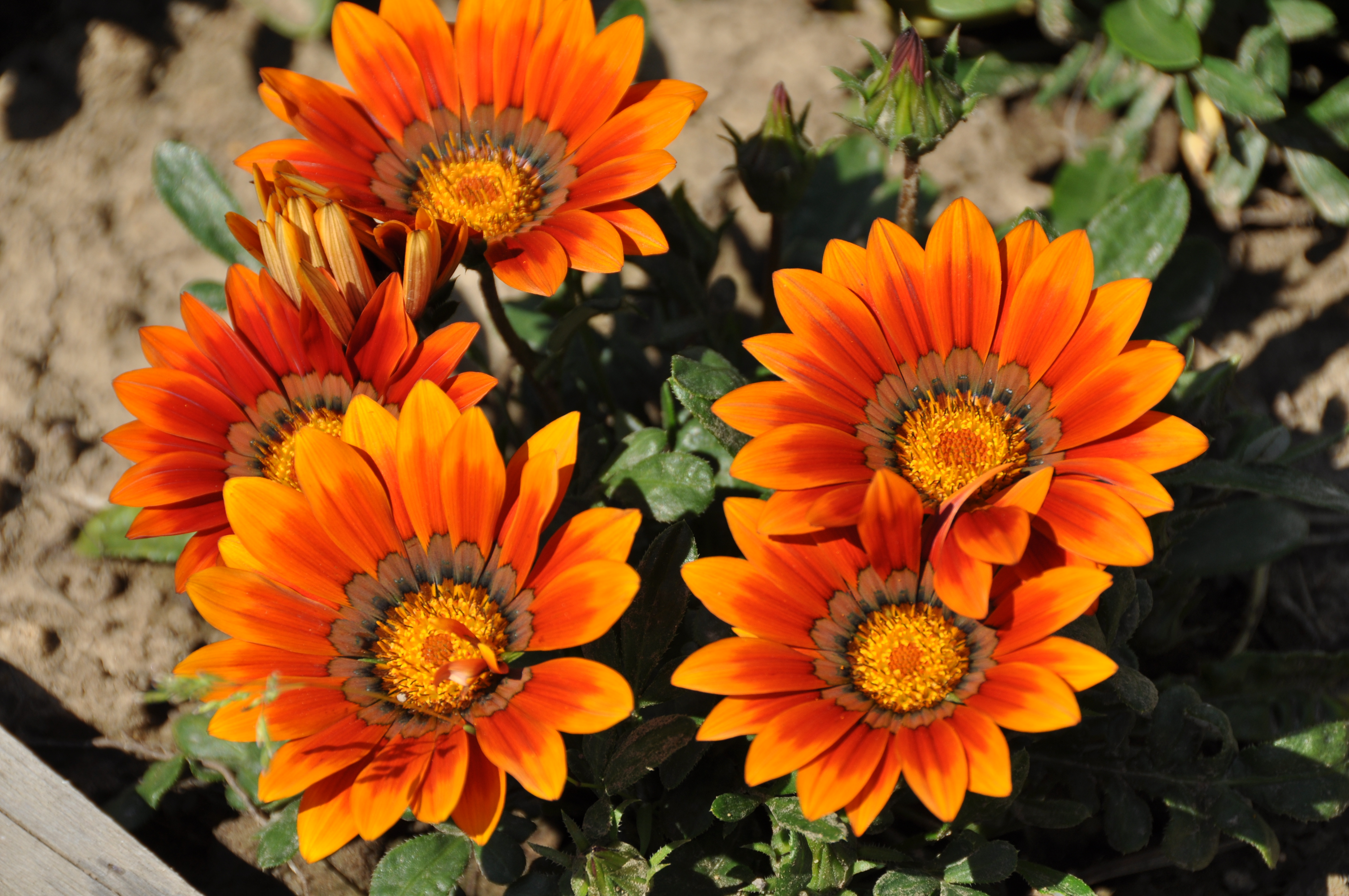Given the limited knowledge about the world of flora, most likely not every novice florist will be able to answer the question of what a gatsania plant is. However, if you see this flower at least once, it will be difficult to forget it. Its main advantage is very bright, beautiful inflorescences, the sight of which is a pleasure.
Many people note that gatsaniya strongly resembles a large chamomile. It is one of the most popular indoor plants due to its rich color palette and ease of maintenance. However, so that this plant does not cause problems in the process of growing in a flower bed, you still have to take into account the characteristics of this plant, as well as follow certain rules of care.
Content
general description
Gazania is one of the brightest representatives of the Asteraceae family, which is usually referred to the group of perennial Asteraceae plants. The genus gatsania includes more than 30 species... Under natural conditions, it can most often be found in Africa. In our country, it is better known as "African chamomile".
The Europeans, who know it as "afternoon gold", also came up with its name. And there is a logical explanation for this, since it is at noon that the plant opens its flowers. After sunset, as well as during bad weather, gatsaniya hides its flowers from others.
 a characteristic feature of gazania is small growth: as a rule, it does not grow above 30 cm. The leaves are formed from a rosette that originates at the roots. Therefore, only a few varieties have a stem, but they also have a rather small stem. The leaves, which have a greenish tint and jagged edges, differ in a variety of shapes. They are quite dense, and have silvery villi on the bottom that help the plant cope with the cold and retain moisture. Throughout its life, a taproot is formed, which is necessary for obtaining moisture from the depths of the soil;
a characteristic feature of gazania is small growth: as a rule, it does not grow above 30 cm. The leaves are formed from a rosette that originates at the roots. Therefore, only a few varieties have a stem, but they also have a rather small stem. The leaves, which have a greenish tint and jagged edges, differ in a variety of shapes. They are quite dense, and have silvery villi on the bottom that help the plant cope with the cold and retain moisture. Throughout its life, a taproot is formed, which is necessary for obtaining moisture from the depths of the soil;- the blooming period of gazania begins in July and lasts until the first frost. At this stage, flower stalks with a length of 25 cm are formed in her rosette, which rise above the leaves. At the highest point are flowers that look like a basket. Gatsania inflorescences are small and have a diameter of about 4–10 cm. The cultivated variety is the determining factor that influences flowering;
- the life cycle of one inflorescence does not exceed three weeks. Keeping in mind that the plant has from 6 to 9 inflorescences, which open one after another at intervals of several weeks, it turns out that the gatsaniya will give its beauty within 100 days. The inflorescences consist of ligulate flowers that are located at the edges, the center is decorated with tubular flowers, where the seeds subsequently ripen.
Gazania has a rich color palette that ranges from white to deep red. Most flowers look spectacular thanks to dark spotslocated at the base of the reed petals, at the sight of which there is an association with the pattern present on the peacock's tail. It is necessary to regularly monitor the moment when the flowers begin to fade.At this time, they must be removed, since new buds will take their place.
The most common types
Before planting gatsania, it will not hurt to decide on the variety, because there are a lot of them, and each has its own characteristics.
Harsh gatsaniya
Among all varieties harsh gazania stands out, thanks to its bright design. Although it belongs to perennials, it is often grown as an annual plant.
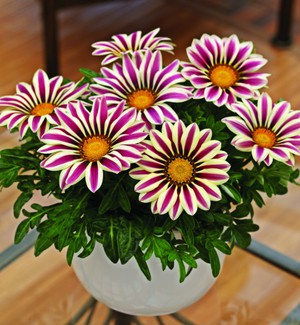 the variety is rather short, reaching a height of no more than 30 cm;
the variety is rather short, reaching a height of no more than 30 cm;- the stems have dark green leaves that grow directly from the base of the stem;
- inflorescences are formed in single baskets: they do not exceed 3-6 cm in length;
- flowers formed at the base are yellow, orange or red with spots;
- the characteristic color of the tubular petals is purple-black.
Hybrid gating
Also in the genus gazania is known hybrid. It appeared due to the crossing of a group of varieties: watery, long-rifle, etc. It is also grown as an annual... Of the peculiarities of the species, it is worth highlighting larger flowers with a diameter of 8 cm. The efforts of breeders, which were undertaken to breed new varieties, were crowned with success: today, double varieties are available to domestic growers, which do not form seeds during the growing season.
Because of this, their can only be propagated vegetatively... Hybrid gatsania inflorescences have a rich color palette, which includes shades from yellow and pink to bronze-red.
Long rifle gatsin
The main feature of long rifle gatsania is compactness. Adult specimens are not taller than 20 cm. Enough its inflorescences are also miniature, reaching a length of 5 cm. The spots that form at the base of the ligulate flowers are usually brown, the characteristic color of the flowers is yellow and orange. Regardless of the variety, the tubular flowers are decorated exclusively in yellow.
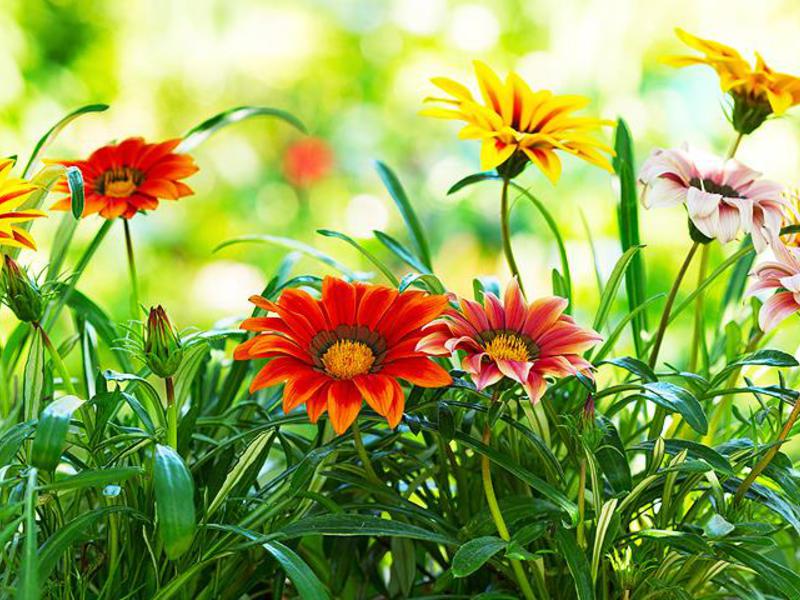
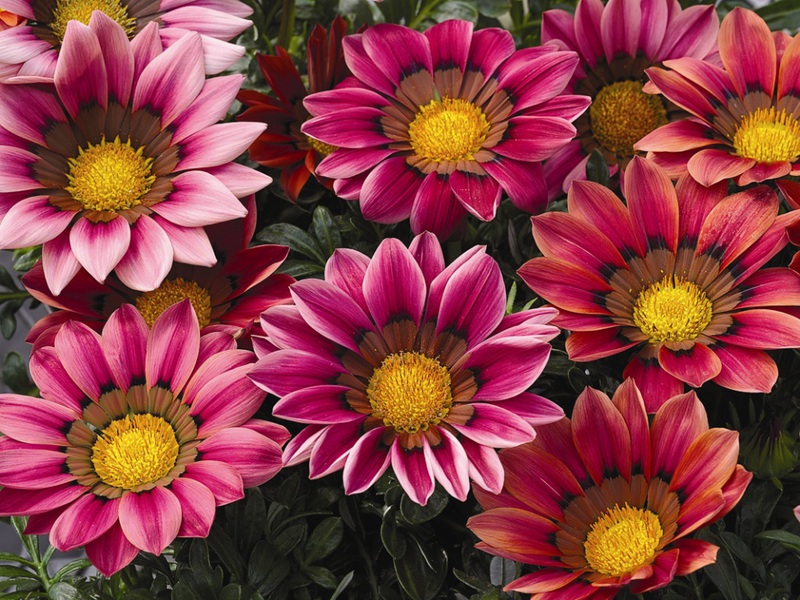


Peacock gatsaniya
Belongs to the group of perennials, the main feature is a stunted stem, elongated leaves, which have a hard pubescence on top. Large flowers are formed during the growing season, the diameter of which is 8 cm. Tubular flowers have a yellow tint, ligulate petals, at the base of which there are black spots - bright orange.
Reproduction and care features
Gatsania belongs to light-loving plants, so when planting in shaded places it is difficult to wait for its flowering. Be sure to pay attention to soil fertility, as well as the presence of drainage. It is important to remember that gatsaniya is a drought-resistant plant for which stagnant water can be fraught with death. The flower is cold-resistant and can withstand temperatures up to -5 degrees Celsius. It also tolerates wind loads well.
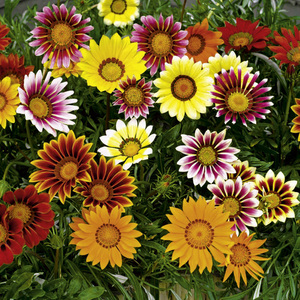 In order to increase the resistance of gazania flowers to diseases, it is recommended to regularly feed with mineral fertilizers at intervals of 4-5 weeks. In soils that contain less nutrients, fertilizers are applied even more often. It is not recommended to choose clay soils for growing gatsania, since there is a high risk of it being affected by various diseases.
In order to increase the resistance of gazania flowers to diseases, it is recommended to regularly feed with mineral fertilizers at intervals of 4-5 weeks. In soils that contain less nutrients, fertilizers are applied even more often. It is not recommended to choose clay soils for growing gatsania, since there is a high risk of it being affected by various diseases.
The main breeding method for gatsania is sowing seeds. But first you have to prepare the ground, in the quality of which use a mixture of sand and peat with the addition of the necessary fertilizers to it. It is recommended to place young plants in a checkerboard pattern not closer than 2-3 cm from each other. You need to be especially careful when growing gatsania in regions with a harsh climate.
- before the first shoots appear, the seeds should be in the soil under glass to maintain the temperature in the garden at 18-22 degrees Celsius. In places with a milder climate, sowing can be carried out directly into the open ground. Seeds begin to germinate as early as the second week.Subsequently, it is imperative to carry out a pick of the seedlings, choosing for this the moment when the first true leaf is formed in the seedlings. During transplantation, it is imperative to break off the tip of the root;
- any suitable container can be used for growing seedlings, such as containers or individual pots. After about 10 days, the seedlings are transplanted to a permanent place. From this point on, caring for gatsania will be reduced to keeping the soil moist. Watering should be regular and carried out at intervals of three times a week;
- you can also grow gatsania indoors, using pots for this purpose. No less common is the option when it is planted in vegetable gardens to receive bouquets, as well as for design purposes when decorating streets and parks. In the latter case, they are planted in flower beds. After cutting, gatsania flowers retain their decorative properties for no longer than five days.
 The above rules for growing, care and reproduction apply to all types of gatzania plants, since each variety responds positively in the world, however, excessive moisture is destructive for them... Therefore, it is enough to follow these recommendations when growing this unpretentious plant, and then gatsania will be able to give you pleasure every season with its bright flowers.
The above rules for growing, care and reproduction apply to all types of gatzania plants, since each variety responds positively in the world, however, excessive moisture is destructive for them... Therefore, it is enough to follow these recommendations when growing this unpretentious plant, and then gatsania will be able to give you pleasure every season with its bright flowers.
Conclusion
Every novice florist should get acquainted with gatsania, because thanks to its extraordinary qualities, it is worthy to start growing it. First of all, it deserves attention for the reason varied design of their inflorescences... But this is not the main thing, since every florist can have such beauty, because Garcinia is distinguished by its unpretentious care. Therefore, in order to be able to admire these flowers, it is enough to familiarize yourself with the basic rules of growing and caring for gatsania and follow them exactly.
You need to immediately remember that gatsaniya is a light-loving plant, so the decision to plant it under the crown of trees or in another place where it will be provided with shade will be a big mistake. After all, then she will not be able to please with abundant flowering. Watering mode is no less important for gating flowers, because with an excess of moisture, it will begin to feel uncomfortable and may soon die. At the same time, gatsania is a cold-resistant culture, therefore it easily tolerates light frosts up to -5 degrees. Therefore, it can be safely planted in a flower bed already in mid-April, when the daytime temperature will steadily stay above zero, without worrying too much about recurrent frosts.
